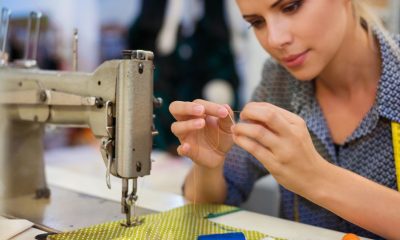Hand Sewing
Four Must-Know Hand Sewing Stitches
Even if you prefer to sew by machine, there will come times when hand stitching is your best option. We’ll go over four must-know hand sewing stitches to get you started.
Hand stitching is usually preferred for finishing waistbands, linings, and hems or when you want to achieve a flawless finish.
Running Stitch
The running stitch is very useful for any application that you need to make a ruche for, such as for gathered skirts. It’s also a great stitch to use when stitching a curved edge because it’ll help prevent stretching.
Many people even prefer to use it for basting seams. This stitch looks the same on either side of the fabric. Generally, you should work from left to right unless you are a lefty.
- Insert your needle into the fabric and pull it back out again.
- Next, weave the needle in and out of the fabric, keeping your stitches as straight and evenly spaced as possible.
Back Stitch
If you have clothing that needs to be mended, this is the stitch you’ll want to use. It creates a very strong seam and is able to get into awkward places that a machine can’t.
On the facing side of the material, the stitch looks just like a straight machine stitch, but on the other side, they overlap.
- This time, working right to the left, insert your needle and pull it through
- Re-insert it about half a centimeter from where the needle just emerged and push it back through about a half centimeter to the left of your first stitch
- Continue this pattern until the end
- At the end, you’ll insert the needle to the right and come out one stitch ahead to the left
Blind Slip Stitch
This virtually invisible stitch is used for just about everything from simple hemming to finishing the edge of a bodice lining. It is one of the most versatile stitches and is perfect when you don’t want your stitching to be visible.
- Press and pin your fabric to prevent slipping
- Insert the needle near the folded edge and pull it through
- Lift a few threads directly from the fabric underneath where the needle emerged, and pull the needle through
- Reinsert it above the point where your needle emerged
- Slide it between the folds and pull it out a centimeter away from where it was inserted
- Repeat until finished, then knot it off
Blind Catch Stitch
This is used almost exclusively for hems, particularly those hems in which flexibility is required.
- Make two folds in the helm, the first 1/4″ and the second 1/2″
- Working left to right, insert your needle into the fold.
- Make a stitch just below the fold, then make another in the main portion of the fabric diagonally toward the right of the other stitch, and pull the needle through. Keep it secure but not tight.
- Make another stitch diagonally up toward the right, just below the fold, followed by another stitch from the main portion of the fabric.
- Repeat until finished, and tie off.
If you learn these four hand sewing stitches, you’ll have all the weapons in your arsenal to create perfectly finished garments. All that is left then is to put them on, and show them off!




























